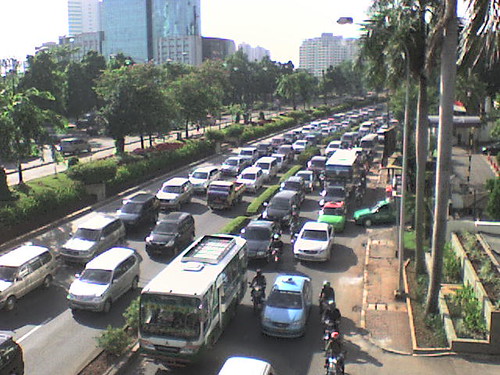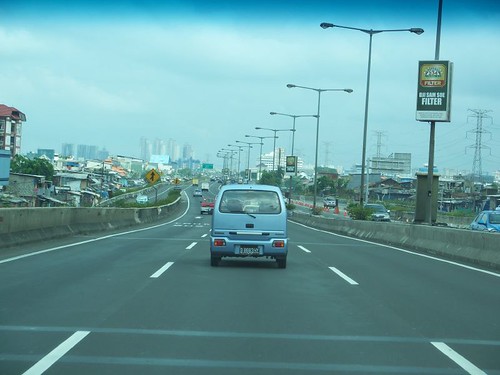
Setiabudi Macet 1, originally uploaded by susiloadhy. Opponents of this policy argued this policy was only another strong evidence of the inability of the government of Jakarta to overcome traffic congestion. Students will be required to wake up early in the morning and they will be sleepy in class. The proposed policy will cause the tardiness of many students and many classrooms will be empty in the morning.
Given the limitation of the Jakarta city administration in overcoming traffic congestion, the policy to change school start time should be considered as a creative and innovative policy. The reaction to this controversial policy from the public should be anticipated by the city administration. The city administration Jakarta government must implement this policy consistently while still working to reduce traffic congestion through other policies.
The traffic congestion in the capital, especially in the morning, will be slightly
reduced through this policy. The intensity of traffic jams in the capital in the peak hours will decrease because of the thirty minutes early trips of the studetns. The argument of the policy will reduce traffic congestion by 14 percent is reasonable. Data Pokok Kependidikan (Primary Data of Education) from the Jakarta's Office of Secondary Education shows that 1.75 million or 21 percent of the 8.3 million inhabitants living in Jakarta in 2006 are school aged people of 7-18 years old.
The traffic congestion in the capital can't be separated from the high rate of vehicle ownership by 9-11 percent per year that is not supported by the growth of road developent which is only less than 1 percent per year. The development of mass transportation system in the capital is still far from the expectation. The busway can reduce the intensity of traffic congestion in the main roads in the city center, but it has still yet to much untangle traffic congestions in other parts of the capital. In addition, the Mass Rapid Transit (MRT), which has long been planned, is stil unclear when to be realized.
Why you should use the Jakarta busway, originally uploaded by fishkid.
Given the various limitations in overcoming traffic congestion through the development of mass transportation system and the high rate of vehicle ownership motor vehicles that is difficult to be controlled, the plan to change school start time is an innovative and creative solution. It is better to implement this policy rather than waiting for the completion of the mass transportation system or the more road built in Jakarta.
In the early implementation of this policy, the city administration needs to tolerate the tardy arrivals of students to schools since the students and parents need some time for the adjustment to the early school hours. Similarly, the availability of public transportation in the early morning needs to be secured to provide services for the students.
In the next stage, the city administration needs to develop school buses that provide shuttle services for students. The provision of school buses will significantly reduce congestion because it will be reduce the number of private vehicles that were previously used to transport the students.
Other alternative that can be considered to reduce congestion school is to implement school attendance zone (rayonisasi). This policy will limit students in their choice of schools. The priority will be given to students who reside near the school. The implementation of this system will shorten the trip distance from the student residence to school, and will ultimately reduce traffic congestion.
In addition, the coordination of the school provision among the municipalities in the Greater Jakarta area needs to be strengthened. The availability of good schools in the Jakarta suburbs is very essential and it will prevent the residents in the suburbs of Jakarta from sending their children to better schools in the central city of Jakarta. The availability of good schools in the buffer areas of Jakarta will ultimately reduce the transportation problem in the capital.
(This article also appeared at The Jakarta Post on December 20, 2008)
Traffic and Change of School Start Time
Assessment of Trans-Java Toll Road

Tol Layang Pelabuhan, originally uploaded by rilham2new.
In the United States, the development of Interstate Highways started in 1956 and this is not the key factor of urban development in the United States. Before the development of Interstate Highway, the railroad system has played an important role in the urban development since the mid-18th century. The railroad system in the United States connects most areas of the United States, from cities on the East Coast to cities in the West Coast. Larger cities such as Chicago, Detroit and Atlanta are examples of cities that grow rapidly due to the infrastructure of the railroad. The development of road transportation becomes an alternative for distributing raw materials and industrial products but does not replace the role of the railroad.
The discussion about global warming and energy crisis put the interstate highways as the cause of the high use of fuel and emission of carbon dioxide. The development of interstate highways also causes suburbanization and urban sprawl. The urban sprawl causes public transport services inefficient and increases residents' dependence on the use of private vehicles.
Indonesia should learn from the negative externalities of the development of interstate highways in the United States. Not only will the development of Trans-Java toll road threaten the national food security due to agricultural land and labor conversion to urban sector, but also increase the fuel consumption as a result of the increased road length. The negative impacts of the development of Trans-Java toll road will be greater if we calculate the environmental impact of the diminishing green areas, including forests and plantations in the island of Java. The development of toll road will also cause the urban sprawl along the toll road.
En route vers Bandung (3), originally uploaded by Popples91.
In sum, we could argue that the development of Trans-Java toll road is not a sustainable solution for stimulating the economic growth in the island of Java. This solution is only a threat to the national food and energy security. The development of Trans-Java toll will not a cost-effective solution for the national interest. Alternatively, we could consider the development of railroad system that is more energy efficient and does not convert as much agricultural land as the development of toll road does.
(This post is an English version of the original article that appeared in the daily newspaper of Kompas on November 20, 2008. The article was also posted in the official websites of Badan Koordinasi Penataan Ruang Nasional and of Direktorat Tata Ruang dan Pertanahan Bappenas)
























